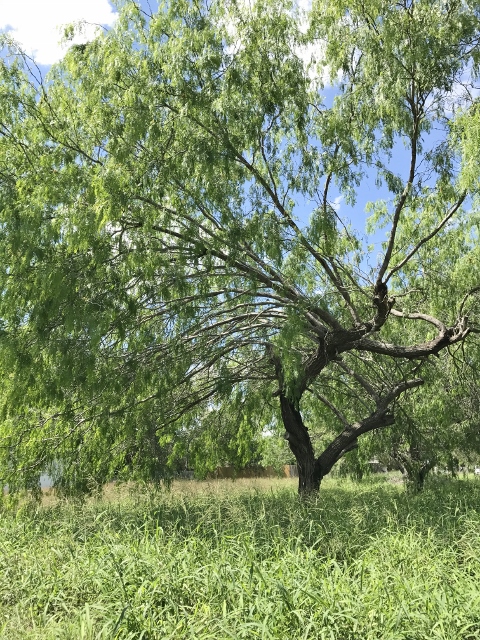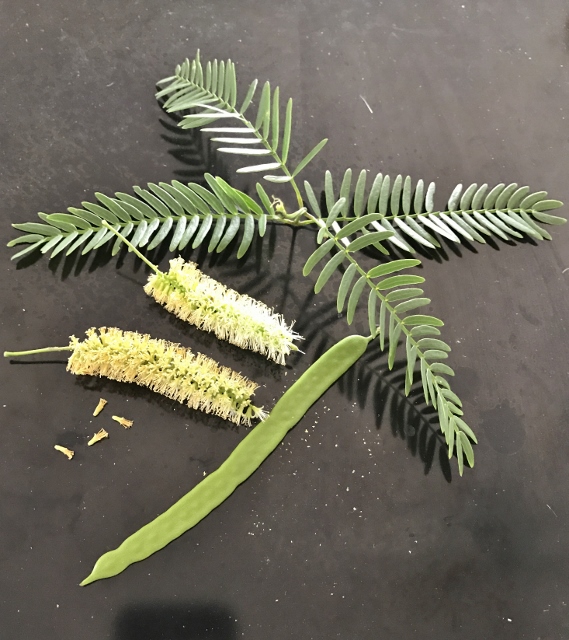

Long live the Texas honey mesquite
by Anita Westervelt, Texas Master Naturalist
For artful creativity, you can’t do better than the honey mesquite, Prosopis glandulosa. With a history as big as Texas, this tree has a strong hold on our native landscape that has served beast and man through the years.
Honey mesquite is one of the easiest trees to recognize from a distance. The dark bark makes a striking contrast to the verdant lime-green leaves. The grace and fall of crooked, sprawling branches adds dramatic impact, each tree defining its own unique shape.
Also called Texas mesquite, the honey mesquite gets its name from its fragrant flowers. Flowering spring through summer, the blooms, called catkins, consist of numerous tiny, five-petal flowers surrounding a three-inch long cylindrical pale green or creamy yellow spike. These flowers are a nectar source for bees that produce a mesquite honey. The flowers attract numerous other pollinating insects.
Mesquite trees grow quickly and furnish shade and wildlife habitat where other trees will not grow. Coyotes, raccoons and other wild animals as well as livestock eat mesquite seedpods, called bean pods.
Those bean pods served native peoples well, too. Tea, syrup, jelly, wine, flour and ground meal have been made from the bean pods. When dried and ground, the meal can be added with other flours when baking breads, pancakes, muffins, cookies and cakes. It is high in calcium, magnesium, potassium, iron, and zinc and rich in the important amino acid, lysine. In the American Civil War, mesquite pods where boiled to make a coffee beverage substitute.
The bean pods, which can reach to 10 inches long, mature in late summer. When mature, they have a sweet coating that has a sugar content of as much as 30 percent. People would chew the sweet coating off the bean pods for a sweet treat. The beans were spit out after the coating was chewed off.
Honey mesquite bark has been used for basketry, fabrics and medicine. The wood, which is very hard and resists rot, is used for making furniture, utensils, tool handles, fence posts, flooring planks, art sculptures and for woodturning. And, as all Texans know, the wood chips add a traditional flavor when barbecuing meats. As firewood, mesquite burns slow and very hot.
Being a legume, the mesquite tree improves nitrogen in the soil where it grows. A very hardy and drought-tolerant tree, they have been known to live for more than two centuries.
Not everyone is enamored with the versatility of the honey mesquite. Ranchers consider them competition with range grasses for moisture. Amazingly, mesquite trees have a long taproot that allows them to locate enough moisture from the water table to sustain life. Their lateral roots can extend far beyond the canopies. They can use water in the upper part of the ground, when available, and can easily and rapidly switch from one water source to the other.
Eradicating mesquite is difficult because the plant’s bud regeneration zone can extend down to six inches below ground level. The tree can regenerate from a piece of root left in the soil.
As a caution, young mesquite branches have three-inch long, heavy-duty thorns strong enough to pierce a tire. Older branches lose the thorns.
The prolific honey mesquite grows in the northern parts of Mexico, covers nearly one-third of the state of Texas and is found in southwestern states where there is low annual rainfall. It has been recognized as one of the toughest trees known to man.
The Rio Grande Valley Chapter, Texas Master Naturalist develops knowledgeable volunteers dedicated to the study and conservation of natural resources and natural areas in the Lower Rio Grande Valley and helps the natural world through service, outreach and education.
